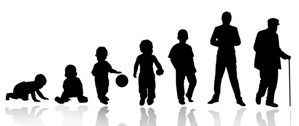Unit 3: Lesson 1: Development
Lesson 1: Development

Lesson 1: Development
How are you different now than you were five years ago? Ten years ago? What are some of the changes that you've experienced?

As we age and move through life, we engage in a continual development process. Development in the life span perspective refers to the changes or patterns of movement that individuals experience. Although we tend to think of development in other areas as growth or a building process, it is a bit different when considering the human life span. There are areas of our bodies and lives that experience growth and advancement as we age, but this process is not always linear, and we may also experience a decline or decrease in some areas of our lives. Thinking about development as patterns of change allows health science professionals to study both the increases and decreases that humans experience physically, mentally, and emotionally.

Why are health science professionals interested in the human life span? Although we all experience life with a unique perspective, we share many similarities with other humans. We learn to walk at about the same age; we may experience certain life events around the same age (such as graduating from high school and retirement), and we may share some similar health and wellness concerns around the same age. Health science professionals can use patterns in development to help study health and wellness issues. They may discover age-related factors that can cause or influence health concerns. Health science professionals also may use these patterns to help prevent specific health issues.
When examining the human life span, we need to keep several essential aspects in mind:
Development occurs throughout our lives. Although it is easiest to see development in young children who change and increase, growth continues until the end of our lives. Health scientists are increasingly studying the emotional and physical changes individuals may experience as older adults.
• Development happens in many areas of our lives. Humans experience physical, mental, emotional, and social development. Within each of these overall developmental areas, many different developmental changes take place. For example, our cognitive or mental development may include changes in memory, abstract thinking, and social intelligence.
• Development has limits. Scholars in this area refer to the limits on development as plasticity. Plasticity refers to the amount of change that is possible or the capacity for change. For example, scientists know that malnutrition can hurt a child's growth. However, even if that child receives the best nutrition possible, they can only grow to a certain height. Scientists believe that about 60-80% of height differences between people are related to genetics (with 20-40% percent reliant on environmental factors like nutrition.)
• Development occurs within different contexts, and contexts change. This means that our development over our life spans occurs within contexts such as families, schools, workplaces, and other settings. Each of these contexts, in turn, is influenced by social, historical, and economic factors. Some influences on the development of an individual within a given context are age-specific, such as puberty. Others are historical, as people alive at a given time may experience a particular event, but people born after the event will not be influenced similarly. Other influences are specific to a context and an individual; we may experience unusual events that affect our personal development, such as a family member's death or winning the lottery.
If you think about these different aspects, you'll see that development is a complex phenomenon throughout our lives. This is one of the reasons why health science professionals carefully study the human life span and development to help us understand our experiences and changes.
Within the context of lifespan development, 'health' can be seen as a developmental construct or one of the ways that people develop. Health involves gains and losses, and it is multidimensional in the sense that many factors affect 'health' (such as the cardiovascular and neurological systems). Examining health through a life span lens helps us to think about aspects such as how our genetic makeup influences us as we age, why some individuals within a particular group/age are healthier than others, and how developmental changes in other areas of our lives influence our overall health.
Video: Embryonic Stem Cells
